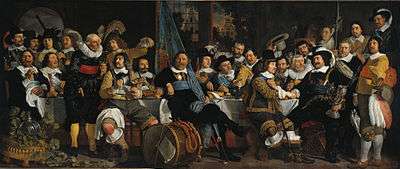Bartholomeus van der Helst
Bartholomeus van der Helst[1] (1613 – buried 16 December 1670) was a Dutch painter. Considered to be one of the leading portrait painters of the Dutch Golden Age, his elegant portraits gained him the patronage of Amsterdam's elite as well as the Stadtholder's circle.[2] Besides portraits, van der Helst painted a few genre pictures as well as some biblical scenes and mythological subjects.[3]
Bartholomeus van der Helst | |
|---|---|
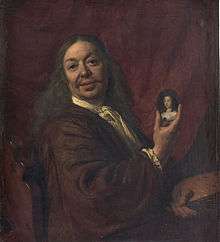 Self-portrait with a miniature of Mary, Princess Royal, 1667 | |
| Born | 1613, Haarlem |
| Died | 1670 (buried 16 December), Amsterdam |
| Nationality | Dutch |
| Known for | Portrait painting |
Notable work | Banquet of the Amsterdam Civic Guard in Celebration of the Peace of Münster |
| Movement | Dutch Golden Age painting |
| Patron(s) | Mary, Princess Royal and Princess of Orange, Amsterdam regency and guild-directors |
Life
Bartholomeus van der Helst was born in Haarlem in 1613. His exact date of birth is not known as the birth records of Haarlem of that time are lost. He was the son of a Haarlem innkeeper called Lodewijk and his second wife, Aeltgen Bartels. Van der Helst had moved to Amsterdam some time before 1636, the year in which he married there Anna du Pire, an 18-year-old woman from a prosperous family from the Southern Netherlands who was already orphaned. The couple had six children of whom one called Lodewijk (1642 - c. 1684) became a portrait painter like his father.[4]
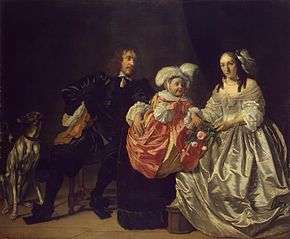
His first dated picture, the Regents of the Walloon Orphanage in Amsterdam, dates from 1637. The style of this painting suggests that in Amsterdam van der Helst may have trained with Nicolaes Eliaszoon Pickenoy.[3] His first important commission was for a large schuttersstuk known as the Civic Guard led by Captain Roelof Bicker and Lieutenant Jan Michielsz. Blaeuw. Van der Helst received the commission in 1639 and finished it in 1642. The large 7.5m wide canvas was hung over the fireplace of the grand assembly of the Kloveniers guild, the same room for which Rembrandt painted The Night Watch. The success, which the artist achieved with this composition, led to many commissions for single and double portraits of Amsterdam's leading class such as his Portrait of Andries Bicker, the mayor of Amsterdam.[2] The city's military brass and wealthy members of the regent class all had portraits made by van der Helst.
Even though van der Helst was active in Amsterdam at the same time as Rembrandt, he was able to become the most popular portraitist in that city, through his elegant and flattering portrayals in the style of Anthony van Dyck. His work was considered more immediately appealing than the dark, intense and introspective work during this later period of Rembrandt.[5] Rare among portrait artists in Amsterdam of his time, he was able to attract bourgeois patrons from other cities such as Rotterdam.[2]
His large group portrait, Banquet of the Amsterdam Civic Guard in Celebration of the Peace of Münster (Rijksmuseum, Amsterdam), was painted in 1648, and exhibited to popular acclaim. It was this painting that sealed his fame for future generations, according to the Dutch artist biographer Arnold Houbraken.[6] The painting was admired by Godfried Kneller and Joshua Reynolds.[5][6] Van der Helst received a commission from the circle of the Stadtholder family, when he was asked in 1652 to paint the portrait of Mary, the widow of William II, Prince of Orange.[2]
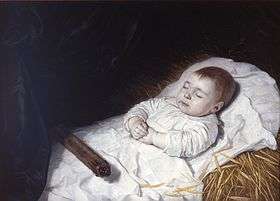
The artist remained active throughout his life and maintained a high level of production until the end of his career. His late works such as the pendant portraits of Lieutenant-Admiral Aert van Nes and his wife Geertruida den Dubbeld and Vice-Admiral Johan de Liefde (all three dated 1668 and in the Rijksmuseum) still set the trend in portrait painting in his age. The harbour scenes in the background in these three works were painted by Ludolf Bakhuizen.[2]
He was the teacher of his son Lodewijk who followed his style.[7] Marcus Waltes was his pupil in 1650.[8] He had no other known pupils but exerted an influence on Govert Flinck, Eustache Lesueur, Constantin Hansen, Alexander Sanders and Abraham van den Tempel.[2][7]
The artist died in Amsterdam in 1670.[2] While the artist had been able to charge very high prices for his work, he appears to have lived above his means. He had bought a large house and acquired many paintings of leading artists such as Frans Floris, Simon de Vos, Goltzius, Adriaen Brouwer, Pieter Lastman, Gerard van Zyl, Simon de Vlieger, Hendrik Gerritsz Pot, Otto Marcelis and Willem van de Velde. After his death his wife was compelled to offer his works and those from his art collection for sale in 1671 in an advertisement in the Haarlems Dagblad.[2][9]
Work
General
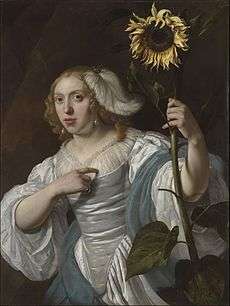
In addition to the portraits for which he is most famous, Bartholomeus van der Helst painted a few genre, historical, biblical, mythological and allegorical scenes.[3][10] In all these paintings, the portrait aspect is still important.[3]
Portraits
Bartholomeus van der Helst was principally a painter of portraits. The majority of his work is made up of individual portraits. He also painted family portraits, double portraits and pendant portraits. An example of the latter are the portraits of Lieutenant-Admiral Aert van Nes and his wife Geertruida den Dubbeld. Among his most prestigious assignments were the group portraits of Amsterdam 'schutters' (civil militia members) and regents. The most famous work in this category is his 1648 Banquet of the Amsterdam Civic Guard in Celebration of the Peace of Münster (Rijksmuseum, Amsterdam).[11] In this large-scale composition depicting 25 people, van der Helst was able to do justice to each individual. He also realised a clear composition through his sophisticated use of light and color.[12]
As a portrait painter to Amsterdam's elite, he created life-sized portraits, which responded to the demand of the patricians of Amsterdam for portraits that offered a good likeness rather than an idealized image. His style is characterized by clear drawing, plasticity, even lighting and a pleasant palette relying on light and clear tones. He preferred balanced compositions.[13]
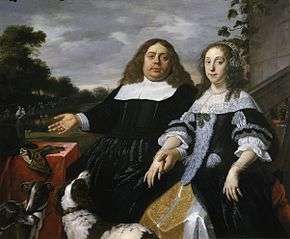
His early works show the influence of Pickenoy, his presumed master, and to a certain extent of Rembrandt. This is clear in the Portrait of an unknown man, probably a Protestant minister of 1638 (Museum Boijmans Van Beuningen). It shows a man reading a book who looks up at the viewer as if he has been disturbed, a motive derived from Rembrandt. The vivid representation of the sitter is characteristic of van der Helst's early work.
Van der Helst found his own style in the 1640s. The Portrait of Andries Bicker dated 1642 (Rijksmuseum, Amsterdam) is typical his work from this period: it is well modeled, of a strong plasticity and painted with a barely visible brush stroke.
The fashion for the French elegant style was visible in his work after 1650. An example is the Portrait of the animal painter Paulus Potter painted in 1654 (Mauritshuis, The Hague). This work was based on a self-portrait of Potter, which he had made shortly before his early death. The gestures and movements of the sitter in the painting are elegant. The artist has further succeeded in rendering the fabrics in a smooth painting style and almost perfect technique.
The paintings of the final years of van der Helst's career are characterized by increased attention to detail and a more even lighting. The subtlety and intensity that characterizes his earlier work has made way for a clarity of expression that leaves nothing to the imagination.[13] The artist also used a more colourful palette and richer contrasts and emphasized more strongly the distinctions between dark and light tones.[14]
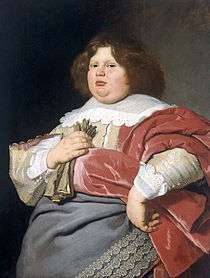
Portrait of Gerard Andriesz Bicker
One of van der Helst's most famous works is the portrait of Gerard Andriesz Bicker at half-length of 1639 (Rijksmuseum, Amsterdam). Van der Helst painted in 1642 a portrait of Andries Bicker, the father of Gerard Andriesz Bicker and the mayor of Amsterdam, as a pendant to this work. The contrast between the two sitters could not be more pronounced: while the father looks like a stern and sober Protestant, the son looks like a fanciful dandy with a smug look in his eyes. At the time the painting was made Gerard Andriesz Bicker was only 17 years old, but already held the titles of Lord of Engelenburg and High Bailiff of Muiden.
This portrait is often used to illustrate the decadent wealth of the Amsterdam merchants of the Dutch Golden Age in Amsterdam.[15]
Genre scenes
Bartholomeus van der Helst also painted a number of genre scenes. An example of a genre scene by van der Helst is the View of the Nieuwmarkt (1638, Hermitage Museum, Saint Petersburg), which combines still life, cityscape and figure piece. The composition shows an old woman holding a big wheelbarrow full of vegetables. On her left hangs the carcass of large slaughtered pig. Next to the pig are four children, one of whom blows the pig's bladder while the others look at the viewer. In the background is a view on the Nieuwmarkt with the Sint Anthoniswaag. This work was probably made for van der Helst's private use as it likely depicts the view from his house on the Nieuwmarkt.[4]
Another genre scene is The Musician (1662, Metropolitan Museum of Art), which depicts a woman tuning a theorbo while a viola da gamba is resting in front of her. Printed music in tenor and soprano parts is placed on a table nearby. The musician looks directly at the viewer as if inviting him to take up the viola da gamba to join her in a duet. While the work has usually been regarded as a genre scene, it is possible that it is in fact a portrait of Anna du Pire, the artist's wife.[16]

Collaborations
As was common in 17th century Dutch artistic practice, Bartholomeus van der Helst regularly collaborated with other specialist artists. A frequent collaborator was Ludolf Bakhuizen, a prominent marine and landscape painter. Bakhuizen painted the marine scenes, which are the backdrop of his portraits of the Dutch naval heroes Vice-Admiral Johan de Liefde and Lieutenant-Admiral Aert van Nes with the pendant portrait of his wife Geertruida den Dubbeld (all three dated 1668 and in the Rijksmuseum).[2]
An interesting case of a collaboration between multiple Golden Age painters is the Portrait of Willem van Wyttenhorst. No less than four painters had a hand in its creation: Bartholomeus van der Helst, Cornelis van Poelenburgh, Jan Both and Jacob Duck. Van der Helst was responsible for the general composition and Jan Both for the landscape. It is possible that Duck painted the harness as he was a specialist in guardroom scenes (also called 'kortegards'), which depicted soldiers at leisure among their weapons, harnesses and other military gear in a guardroom. It is likely that van der Helst also painted the face but the role of van Poelenburgh is not clear.[17]
Van der Helst also collaborated with the animal painter Jan Baptist Weenix on the Shepherd boy with sheep and goats. Bartholomeus van der Helst painted the shepherd boy in the painting. Van der Helst scratched his signature in the wet paint on the boy's collar while Weenix did the same in the wet paint at the upper right. It is believed the painting was intended to be hung over a large fireplace. This probably explains the contrived perspective with the somewhat too large sheep placed right on the edge in the foreground.[18]
Gallery
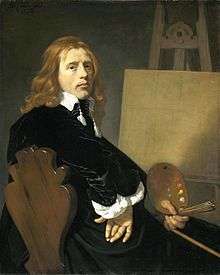 Portrait of the animal painter Paulus Potter
Portrait of the animal painter Paulus Potter.jpg) Portrait of a boy blowing bubbles
Portrait of a boy blowing bubbles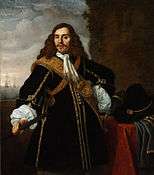 Portrait of Captain Gideon de Wildt
Portrait of Captain Gideon de Wildt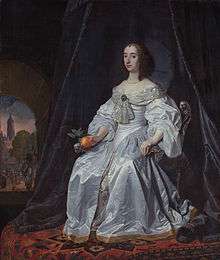 Mary, Princess of Orange
Mary, Princess of Orange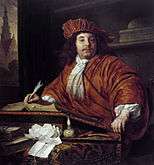 The shipowner Daniel Bernard
The shipowner Daniel Bernard%2C_by_Bartholomeus_van_der_Helst.jpg) The arms dealer Jacob Trip (1627-1670)
The arms dealer Jacob Trip (1627-1670)%2C_luitenant-admiraal%2C_by_Bartholomeus_van_der_Helst.jpg) Lieutenant-Admiral Aert van Nes (1626–93)
Lieutenant-Admiral Aert van Nes (1626–93)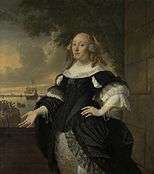 Geertruida den Dubbeld, wife of Lieutenant-Admiral Aert van Nes
Geertruida den Dubbeld, wife of Lieutenant-Admiral Aert van Nes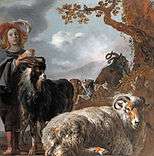 Shepherd boy with sheep and goats, together with Jan Baptist Weenix
Shepherd boy with sheep and goats, together with Jan Baptist Weenix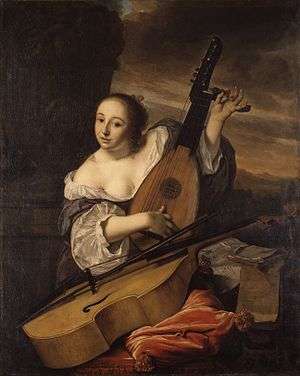 The Musician
The Musician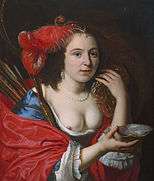 The artist's wife Anna du Pire as Granida
The artist's wife Anna du Pire as Granida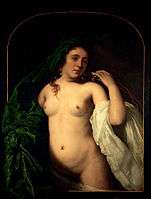 Nude young woman lifting a curtain
Nude young woman lifting a curtain
References
- Dutch name variations: Bartel van der Elst, Bartelmeus van der Elst, Bartholomeus van der Elst, Bartel van der Helst, Bartelmeus van der Helst, Bartel Verelst, Bartelmeus Verelst, Bartholomeus Verelst, Bartel Verhelst, Bartelmeus Verhelst, Bartholomeus Verhelst
- Walter A. Liedtke, Dutch Paintings in the Metropolitan Museum of Art, Volumes 1-2, Metropolitan Museum of Art, 2007, pp. 223-331
- Rudolf E. O. Ekkart. "Helst, Bartholomeus van der." Grove Art Online. Oxford Art Online. Oxford University Press, accessed 15 May 2017
- Website about Bartholomeus van der Helst (in Dutch)
- Bartholomeus van der Helst at the J. Paul Getty Museum
- Arnold Houbraken, Bartholomeus vander Helst biography in: De groote schouburgh der Nederlandsche konstschilders en schilderessen, 1718
- Bartholomeus van der Helst at the Netherlands Institute for Art History (in Dutch)
- Judith van Gent, Bartholomeus van der Helst blog (in Dutch)
- Advertisements in the Oprechte Haerlemse Courant of 1671 Archived November 21, 2008, at the Wayback Machine (in Dutch)
- Bartholomeus van der Helst, A Young Woman Holding a Sunflower Archived 2017-05-15 at the Wayback Machine At Otto Naumann
- Judith van Gent, Stilistische ontwikkeling at Bartholomeus van der Helst blog (in Dutch)
- S. A. C. Dudcok van Heel, Bartholomeus van der Helst (Haarlem 1613 – 1670 Amsterdam), The Marriage Portraits of Gabriel Marselis and Maria van Arckel, at Otto Naumann Ltd, 2013
- Judith van Gent, Stilistische ontwikkeling at Bartholomeus van der Helst blog (in Dutch)
- Bartholomeus van der Helst, Portrait of a gentleman against a drapery backdrop at Dorotheum
- Maarten Levendig, Bartholomeus van der Helst: Portrait of Gerard Andriesz. Bicker (1639); Rijksmuseum, Amsterdam
- Bartholomeus van der Helst, The musician at the Metropolitan Museum of Art
- N.C. Sluijter-Seijffert, Cornelis van Poelenburch als portretschilder, in: E. Buijsen, Ch. Dumas, V. Manuth (red.), Face Book. Studies on Dutch and Flemish Portraiture of the 16th-18th Centuries. Liber Amicorum presented to Rudolf E.O. Ekkart on the occasion of his 65th Birthday, Leiden 2012, pp. 161-166 (in Dutch)
- Jan Baptist Weenix and Bartholomeus van der Helst, Shepherd boy with sheep and goats at Sotheby's
External links
![]()
